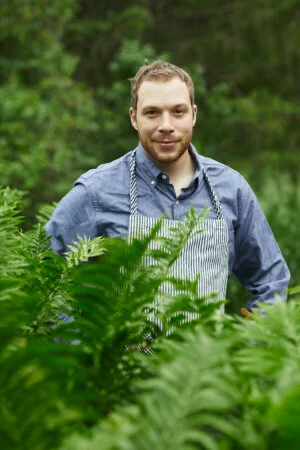Chef Alan Bergo talks about root-to-flower cuisine, foraging, and some unexpected flavours.
Our guest today, Chef Alan Bergo, looks at vegetables through the eyes of a forager. He’s passionate about using parts of the plant that are often overlooked.
Chefs using a whole animals might use the term nose-to-tail cooking. Bergo takes this approach with his vegetables, using a root-to-flower approach.
Bergo is the author of the new book, The Forager Chef’s Book of Flora: Recipes and Techniques for Edible Plants from Garden, Field, and Forest.
Often-Forgotten Plant Parts
Bergo talks about using squash tips in the kitchen. “The squash is a perfect example of how foraging and looking for different ingredients changed how I consider vegetables that I thought I knew,” he says.
His advice for cooking squash shoot tips? Cook gently and delicately. Steam them, or blanch for one minute…or barely wilt them in a pan.
Other often-forgotten plant parts include:
Fennel fronds. Bergo likes to combine these with parmesan cheese and bread crumbs to make into cakes.
Carrot leaves. He suggests simmering them in salted water. They keep their shape and texture when gently cooked, and can then be used like salad.
Unripe sunflower heads. They have the texture of an artichoke along with a strong sunflower flavour.
Foraged Ingredients
Sochan. Bergo explains that leaves from this rudbeckia family member can be harvest three to four times over a year. The leaves formed after the flower stalk dies back are different—and are his favourite. Older leaves have a stronger flavour.
Nettles. He finds that common nettle has more of a “saline” or “oceanic” taste than Canada nettle.
Milkweed flowers can be used to make drinks with an intensely fruity flavour.
Meadowsweet flowers have an almond-like taste. Bergo says that a good way to catch floral aromas is by using cream.
Black walnut. Young nuts can be used to make a jam and ketchup.
Pine pollen. It’s used in China and the Middle East to make sweets.
Thoughts on Flavour
Bergo talks about flavours that are shared amongst plants in the same families, recounting the time he served dolmas made using galinsoga leaves, only to have people ask him if they contained artichoke.
Another example of a shared flavour is the hint of almond that shines through in plum-kernal oil or Saskatoon berries.
Bergo’s Top Tips
Steaming greens keeps more flavour than blanching.
Try something new!
Connect with Alan Bergo
Website: foragerchef.com
Instagram: foragerchef
If this episode piqued your interest in foraging, you might like these episodes:
Neighbourhood Foraging for the Wild Food Gourmet. We spoke with forager Robin Henderson in May 2020. Henderson is the author of The Neighborhood Forager
Foraging as an Outdoor Classroom. We chatted with forager and teacher Mike Krebill in March 2021, and hear about his grade-seven elective course on foraging.


